We are not completely hopeless when it comes to trying to prevent landslides and mitigate the risk to communities. The following list of techniques and technologies is a summary of commonly used methods for landslide mitigation, adapted from A Guide for Management of Landslide-Prone Terrain in the Pacific Northwest (Government of BC, 1994) and The Landslide Handbook— A Guide to Understanding Landslides (USGS, 2008). It is highly recommended that these documents are referred to for those who require more detailed information. Other useful online resources are provided for many of the techniques and technologies. An engineer or geologist must be consulted before any of these mitigation methods are implemented.
Earth Slope Stabilization / Mitigation
Excavation
Removing soil from the head of a slide
Since the driving force of landslides is generated from the head of the slide, excavating the top of a slope therefore improves its stability. This, however, only is suitable for rotational landslides and is ineffective for translational or flow-type landslides.
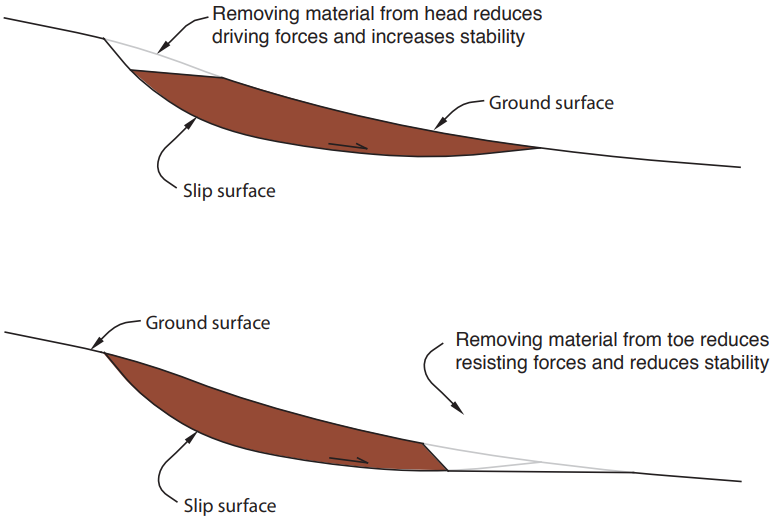
Reducing height and/or slope angle
Reducing the height and angle of a slope reduces the driving force by reducing the weight of the soil. For height reduction, this method usually only increases the Factor of Safety by only 10-15 percent.
Backfill with lightweight material
If reducing the overall height of the slope is not possible, backfilling with a lightweight material is possible to reduce the driving force on the failure plane. Materials such as wood chips or logging slash are commonly used.
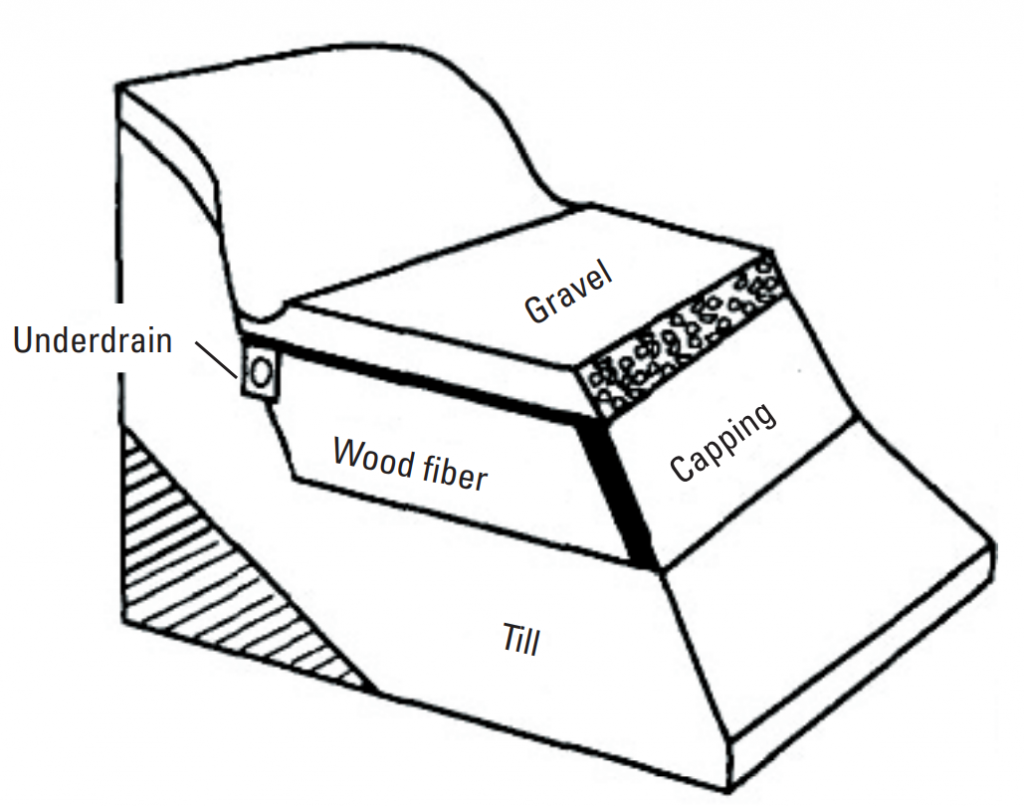
Benches
Forming benches on a slope, or terracing, can also reduce the driving force. This technique, however, is effective for reducing the chance of shallow failures, although it does not improve the overall slope stability. Benches are most useful for controlling surface drainage and serving as protection structures under areas prone to rockfalls. Outward sloping should be used in areas with low rainfall and permeable soil, level should be used in areas with moderate rainfall and highly permeable soil, and inward sloping should be used in areas of heavy rainfall and less permeable soil.
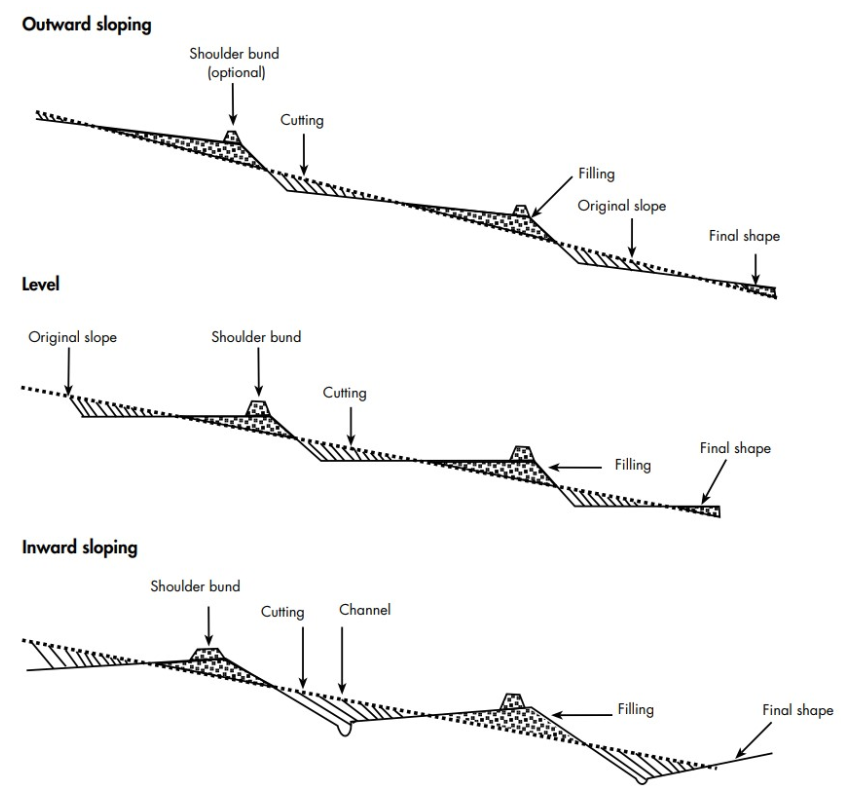
Strengthening slopes
Mesh reinforcement materials
There are many soil reinforcement materials available, which are usually made of concrete or plastic. These materials increase the bearing capacity of the subsoil and increase slope stability by reinforcing soil strength, improving soil drainage, and retaining-wall construction.
See https://texdelta.com/en/blog/reinforcement-mesh-to-prevent-slope-erosion/ for information on installation and considerations.

Rock-fill buttresses at the toe of slope
The stability of a slope can also be improved by adding weight at the toe to create a counterforce that resists failure. Riprap is preferable to soil or other smaller grain material as it has a greater frictional resistance to shear forces and allows for drainage.
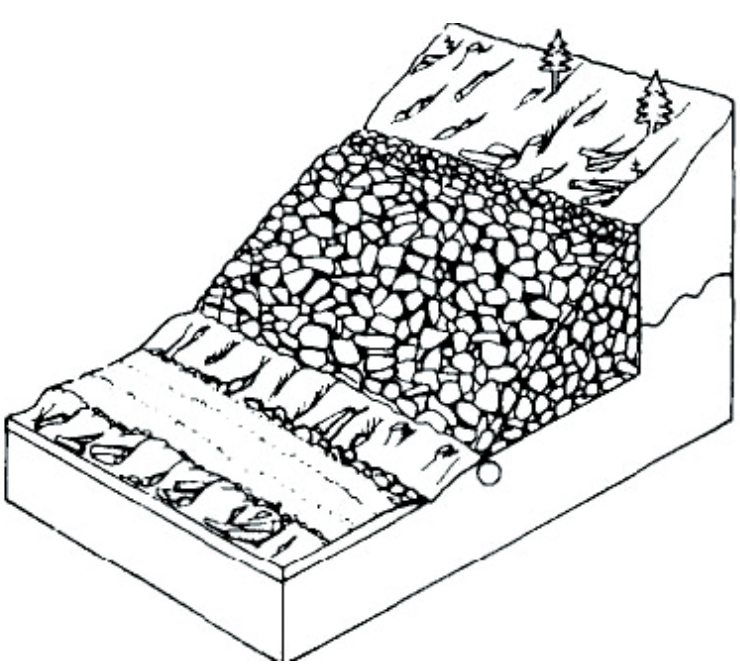
Drainage Techniques
Site leveling
Since water adds more shear force to the slope, preventing standing water in depressions along the slide surface will alleviate some of this force. It is important to prevent surface water from reaching the failure plane and infill large cracks in the soil surface.
Ditches and drains
Surface drainage can be achieved through ditches or subsurface drains. The base of a ditch should be graded at minimum 2 percent to ensure the water flows quickly away from the unstable area. The simplest subsurface drain is a lateral trench installed above the head of an unstable slope, however they are only economically viable in shallow soils where ground-water flowing along the failure plane can be intercepted.
See A Design Method For Landslide Surface Water Drainage Control (Haugen, 2007) for a step by step design process for surface water drainage.
Drain pipes
Slotted PVC horizontal drain pipes are effective in removing ground-water in deep soils. The pipes, however, need to be installed properly, intersect the failure plane, and actually drain the soil for them to be effective. They are most effective when installed during the initial excavation.
Straw wattles and bales
Also known as straw worms, bio-logs, straw noodles, or straw tubes. They are compressed straw cylinders encased in jute or nylon that intercept water, preventing erosion on a slope and enabling seeds to germinate aiding the revegetation process. Straw wattles are effective on slopes up to 70 percent, but their effectiveness diminishes on slopes steeper than 50 percent, and are effective for 1-2 years.
See https://graniteseed.com/blog/straw-wattles-guide/ for more information on uses and benefits.
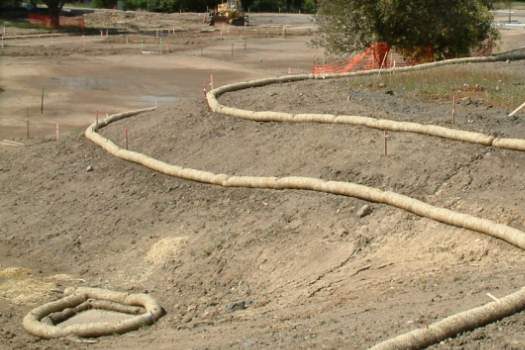
Retaining walls
Timber crib
Timber crib walls are interlocking log box structures that are backfilled with coarse aggregate. They force the potential failure surface to a deeper and less critical depth by intersecting the sliding surface. The walls should be built to a sufficient depth, extending beyond the critical failure plane, to withstand shearing, overturning, and sliding. They are only effective in stabilized and relatively small soil volume and most effective on slopes that have a thin unstable soil layer on top of a more stable layer.
See https://onlinepubs.trb.org/Onlinepubs/sr/sr160/160-013.pdf for an in-depth review of timber crib walls.
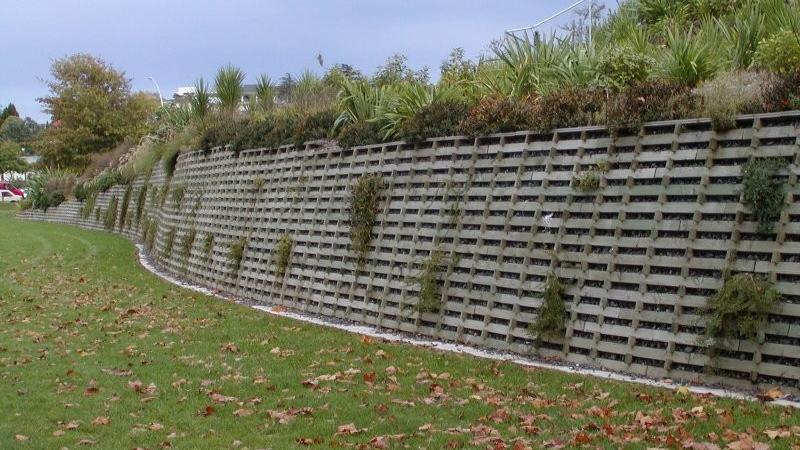
Steel bin wall
Steel bin walls are similar to timber cribs but made from corrugated galvanized steel components and bolted together to form a box. The structure is then filled with soil that is well draining and compacted, which makes up the majority of the weight. Engineering charts provide typical loading conditions for stringer (horizontal member) specifications and height to width ratios.
See https://www.conteches.com/Portals/0/Documents/Brochures/Bin-Wall%20Bro.pdf?ver=2018-05-16-090419-263 for more information and engineering charts.
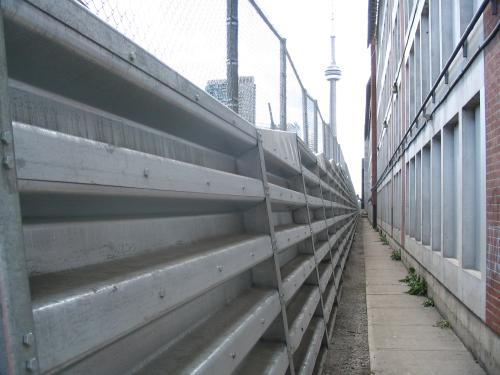
Gabion wall
Gabions are wire mesh containers filled with cobble-sized rocks and can be stacked to create retaining walls. The weight of the wall increases the friction of the soil underneath, therefore adding more stability to the foundation soil. They are inexpensive and easily installed.
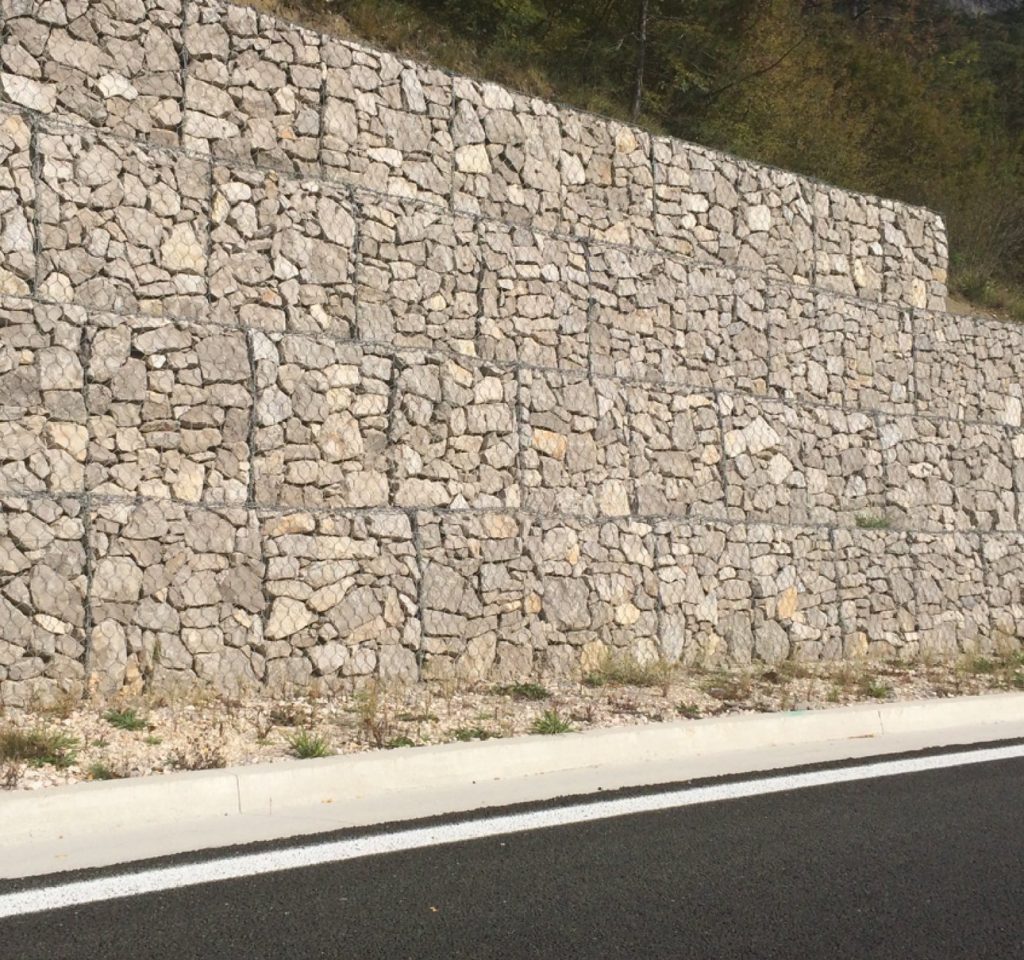
Piles
Large diameter concrete piles can be placed at the base of a slope to create a wall. They should extend past the failure surface and firmly placed into the subsoil. Pile walls are primarily used to reinforce a slope to allow for excavation in front of them and are only suitable where there is a relatively small soil volume to be stabilized.
Vegetation
Seeding a slope, either through dry seeding or hydroseeding, adds stability to a slope by anchoring the soil in place with plant roots. This softer approach to landslide mitigation is effective for surface erosion and shallow slope failures, however larger-scale erosion will require engineered technology to prevent. The slope should be made as stable as possible prior to seeding. Mulch can also be used to prevent surface erosion from rain.
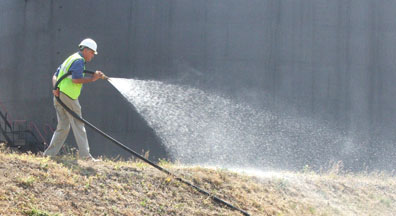
Rock Slope Stabilization / Mitigation
Safe catching techniques
Catch ditches
Catch ditches that are properly designed, taking into account the geometry of the cliff and covered with loose soil to prevent bouncing or shattering, are effective in containing rock falls. They can be built with gabion walls if there is not enough space for the proper width of the ditch.
Cable, mesh, fencing, and rock curtains
Cable lashing and wire nets are inexpensive and simple ways to protect infrastructure from rock falls. Metal cables can be wrapped around large unstable blocks and anchored. For smaller unstable rocks, wire mesh can be used to prevent them from falling. Catch nets can be constructed at the bottom of slopes to dissipate the energy of a falling rock and stop rocks up to 1 meter in diameter. Rock fences are effective at preventing rocks from falling onto infrastructure, however rocks may still bounce over the barrier. Rock curtains direct falling rocks into a catch ditch to prevent them from bouncing onto infrastructure.
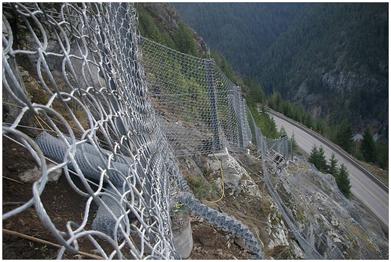
Catch fence near Cache Creek, British Columbia (from tranbc.ca)
Retaining walls
Similar to rockfall fences, retaining walls keep debris out of an area but they are more substantial. They must be properly anchored so they can withstand a rockfall event and not tip over.
Rock sheds/shelters
Rock sheds and shelters are structures built over roads or other infrastructure to protect the area from rockfalls and rock avalanches. They can either be open ended or fully cover the rockfall area and the design can vary greatly.

Excavation of rock
Benches
Similar to benches for earth slope mitigation, benches can be excavated into a rock face to reduce tension in the surface rock and reduce erosion. They are one of the most effective ways to stabilize rock slopes, however they have little to no effect on deep-seated failures. The width of each bench should be at least 4 meters, vertical bench-face angles should be avoided, and all benches should have proper drainage to divert water away from the slope.
Scaling and trimming
Unstable and hazardous rocks can be removed by scaling, removing loose rocks with pry bars, and by trimming, which is done by drilling and blasting then scaling the remaining material. This may need to be done every few years as the surface rock becomes more eroded and unstable.

Reinforcing potential rockfall areas
Shotcrete and gunite
Shotcrete is the spraying of concrete or mortar applied onto an unstable rock surface, either by a dry or wet-mix process. Gunite specifically refers to the spraying of dry-mix concrete or mortar. Both are a quick and relatively simple method to reinforce unstable rock surfaces and reduce weathering over time.
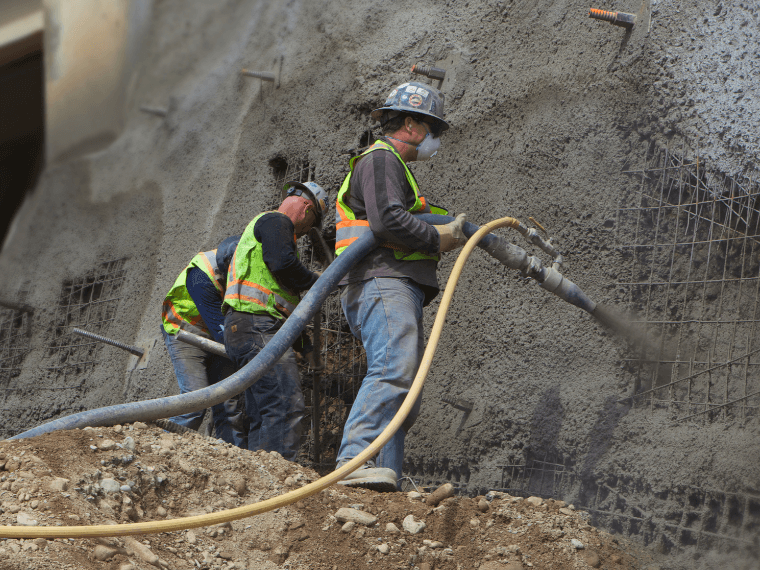
Anchors, bolts, and dowels
These tools are steel rods or cables that improve the stability of a rock face by tying it together. Anchors are post-tensioned rods that support large blocks of rock, while bolts are shorter and support the surface of the rock. Dowels function the same as bolts but are not post-tensioned. Correctly determining the orientation of the potential failure surfaces is vital to the success of an anchor system, which requires considerable engineering experience.
See https://www.larimit.com/mitigation_measures/993/ for more information on anchors.
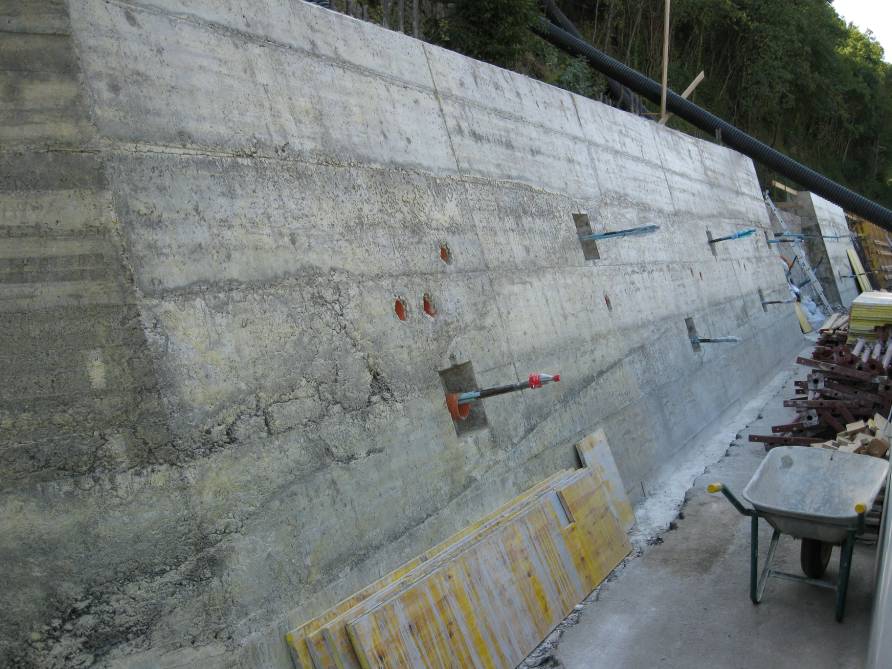
Debris-Flow Mitigation
Strengthening slopes for erosion/debris flows
Strengthening the soil
Resisting erosion helps to prevent larger slope failures and drainage problems. This can be done with straw or wood chips as they are effective in holding the soil in place, or with burlap tied down with stakes. Burlap is commonly used after planting a slope, providing temporary stability while the vegetation becomes established as the burlap decomposes.
Governors Island, New York, in particular the second phase ‘The Hills’, is a good example of using temporary erosion control mats while vegetation anchors become established.
https://urbannext.net/governors-island-transformation/
https://www.archdaily.com/791454/the-hills-by-west-8-set-to-open-on-governors-island
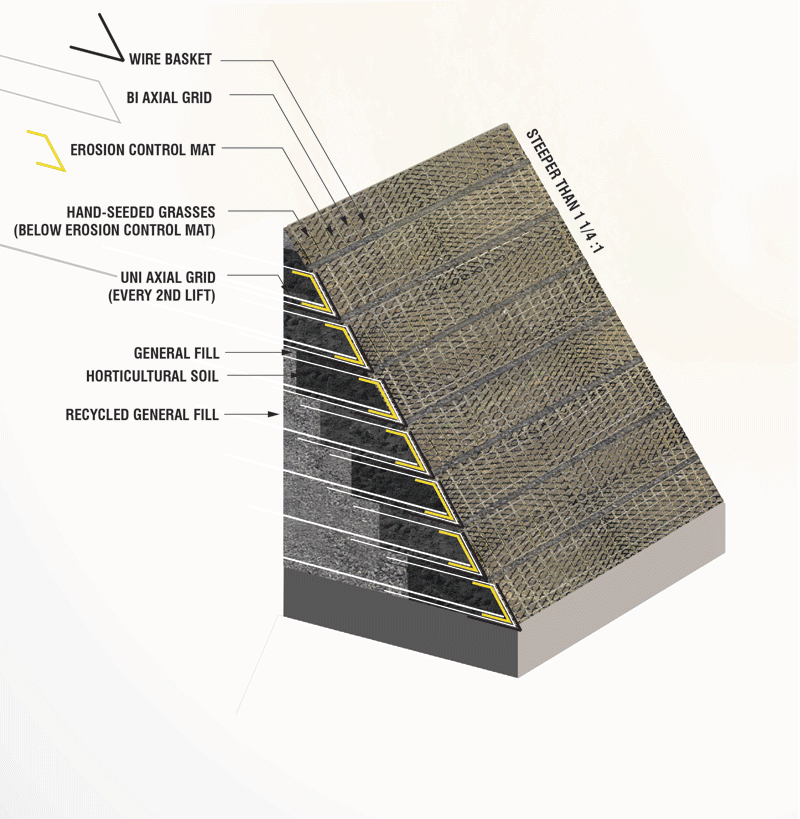
Proper planting on slopes
Proper planting techniques vary from site to site, however some general approaches are to replant barren or burned areas, not overwatering, and to correct any problems as soon as possible.
Keep slopes free of wildfire fuel
Following a wildfire, the intensity and likelihood of a debris-flow on a slope increases when it becomes saturated by rainfall. Limiting wildfire fuel, such as piles of deadwood and dead plants, helps prevent the spread of wildfires.
Structures for mitigating debris flows
Debris-flow basins
In areas where debris-flows are common, basins are commonly built to protect sensitive waters or infrastructure that could be damaged. The basin will eventually fill up and will need to be emptied so it does not overflow. They should also be designed to contain the maximum flow volumes to prevent overflowing during an event.
See https://www.larimit.com/mitigation_measures/1011/ for more information.
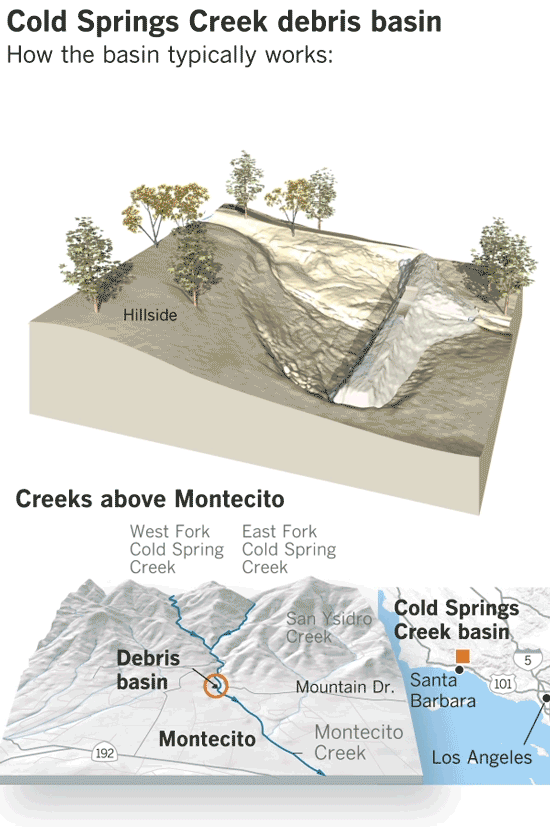
Check dams
Check dams are an expensive method for mitigating debris-flow risk, however channelized debris-flows serve three purposes when installed in channels (following information quoted from Government of British Columbia, 1994, p. 153).
- Reduce the incidence of failure by reducing the channel gradient in the upper channel.
- To reduce the volume of channel-stored material by preventing downcutting of the channel with subsequent gully sidewall destabilization, and by providing toe support to the gully slopes.
- Store debris flow sediment, when installed in the lower part of the channel.
They can be built out of reinforced concrete (up to 8 meters in height) or log cribs (up to 2 meters in height). The main drawbacks are lateral stream erosion and scouring by spillway water.
See https://www.larimit.com/mitigation_measures/1029/ for more information.

Retaining walls
Retaining walls can be used to block the flow or divert it around a vulnerable area. When diverting a potential debris-flow, attention should be put on where the flow is being deflected so it is not being redirected into another vulnerable area.
Profession Opportunities
Landscape Architects
- Small scale excavation
- Drainage away from high risk areas
- Retaining walls
- Strengthening slopes
- Vegetation
- Design for human and non-human experience
Planners / City Officials
- Maintenance of hazardous material (i.e. loose rocks and wildfire fuel)
- Education and information for business and home owners
- Early warning systems (see Keegan, 2022)
Engineers
- Large scale excavation
- Strengthening slopes and rockfall areas
- Basins, check dams, and retaining walls
- Safe catching techniques
- Consulting with city officials and architects
